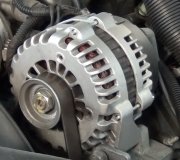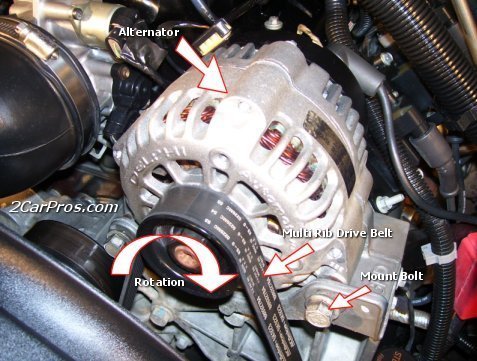Sunday, February 26th, 2017 AT 10:07 PM
Battery light stays on
3 Replies
Start by measuring the battery voltage, first with the engine off, but mainly with it running. With it running, you must find between 13.75 and 14.75 volts. Tell me what you find. That will tell us where to go next.
Was this helpful?
Yes
No
Sunday, February 26th, 2017 AT 10:30 PM
Dandy. That means it is okay to do the rest of the tests, but that requires a professional load tester. The charging system needs to be tested for "full-load output current" and "ripple" voltage.
All AC generators use at least six diodes. Those are one-way valves for electrical current flow If one of those diodes fails, you will lose exactly two-thirds of the generator's output capacity. 30 amps from the common 90-amp generator is not enough to run the entire electrical system under all conditions. The battery will have to make up the difference until it slowly runs down, often over days or weeks.
Since GM redesigned their generators for the '87 model year, they have had a huge problem with voltage spikes and repeat failures. Those spikes can damage the internal diodes and voltage regulator, and interfere with computer sensor signals. The battery is the key component in damping and absorbing those spikes, but as they age and the lead flakes off the plates, they lose their ability to do that. To reduce the high number of repeat generator failures, always replace the battery at the same time, unless it is less than about two years old.
All AC generators put out three-phase current. The voltage remains very steady and smooth. With one failed diode, one phase of output is lost. Voltage drops a lot when that missing phase is supposed to be occurring. That drop in voltage is what causes ripple voltage. It's the difference between normal output voltage and what it drops to. The 14.32 you found is the normal output voltage, but you need the professional load tester to measure what it drops to. A few will actually list the ripple voltage as a measured value on a printout, but most just display it on a relative bar chart between "low" and "high".
While your output voltage is fine, the voltage regulator will turn on the "Battery" light if it is responding to the ripple voltage. In some cases the regulator can be damaged and fail to turn the light off even though it is running the generator just fine. These generators were not designed to be repaired. There are kits available now from aftermarket suppliers, but it is almost impossible to get them apart without destroying the diode block. If you do get that far, there is no way to test the voltage regulator or know if it is okay, so that must be replaced too. Due to the high difficultly, and the high cost of parts, it is better to just buy another rebuilt generator. Since you already have a new battery, that doesn't need to be replaced again.
All AC generators use at least six diodes. Those are one-way valves for electrical current flow If one of those diodes fails, you will lose exactly two-thirds of the generator's output capacity. 30 amps from the common 90-amp generator is not enough to run the entire electrical system under all conditions. The battery will have to make up the difference until it slowly runs down, often over days or weeks.
Since GM redesigned their generators for the '87 model year, they have had a huge problem with voltage spikes and repeat failures. Those spikes can damage the internal diodes and voltage regulator, and interfere with computer sensor signals. The battery is the key component in damping and absorbing those spikes, but as they age and the lead flakes off the plates, they lose their ability to do that. To reduce the high number of repeat generator failures, always replace the battery at the same time, unless it is less than about two years old.
All AC generators put out three-phase current. The voltage remains very steady and smooth. With one failed diode, one phase of output is lost. Voltage drops a lot when that missing phase is supposed to be occurring. That drop in voltage is what causes ripple voltage. It's the difference between normal output voltage and what it drops to. The 14.32 you found is the normal output voltage, but you need the professional load tester to measure what it drops to. A few will actually list the ripple voltage as a measured value on a printout, but most just display it on a relative bar chart between "low" and "high".
While your output voltage is fine, the voltage regulator will turn on the "Battery" light if it is responding to the ripple voltage. In some cases the regulator can be damaged and fail to turn the light off even though it is running the generator just fine. These generators were not designed to be repaired. There are kits available now from aftermarket suppliers, but it is almost impossible to get them apart without destroying the diode block. If you do get that far, there is no way to test the voltage regulator or know if it is okay, so that must be replaced too. Due to the high difficultly, and the high cost of parts, it is better to just buy another rebuilt generator. Since you already have a new battery, that doesn't need to be replaced again.
Was this helpful?
Yes
No
Tuesday, February 28th, 2017 AT 4:59 PM



